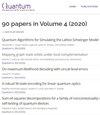Ground state energy and magnetization curve of a frustrated magnetic system from real-time evolution on a digital quantum processor
IF 5.1
2区 物理与天体物理
Q1 PHYSICS, MULTIDISCIPLINARY
引用次数: 0
Abstract
Models of interacting many-body quantum systems that may realize new exotic phases of matter, notably quantum spin liquids, are challenging to study using even state-of-the-art classical methods such as tensor network simulations. Quantum computing provides a promising route for overcoming these difficulties to find ground states, dynamics, and more. In this paper, we argue that recently developed hybrid quantum-classical algorithms based on real-time evolution are promising methods for solving a particularly important model in the search for spin liquids, the antiferromagnetic Heisenberg model on the two-dimensional kagome lattice. We show how to construct efficient quantum circuits to implement time evolution for the model and to evaluate key observables on the quantum computer, and we argue that the method has favorable scaling with increasing system size. We then restrict to a 12-spin star plaquette from the kagome lattice and a related 8-spin system, and we give an empirical demonstration on these small systems that the hybrid algorithms can efficiently find the ground state energy and the magnetization curve. For these demonstrations, we use four levels of approximation: exact state vectors, exact state vectors with statistical noise from sampling, noisy classical emulators, and (for the 8-spin system only) real quantum hardware, specifically the Quantinuum H1-1 processor; for the noisy simulations and hardware demonstration, we also employ error mitigation strategies based on the symmetries of the Hamiltonian. Our results strongly suggest that these hybrid algorithms present a promising direction for studying quantum spin liquids and more generally for resolving important unsolved problems in condensed matter theory and beyond.从数字量子处理器上的实时演化看挫折磁系统的基态能量和磁化曲线
本文章由计算机程序翻译,如有差异,请以英文原文为准。
求助全文
约1分钟内获得全文
求助全文
来源期刊

Quantum
Physics and Astronomy-Physics and Astronomy (miscellaneous)
CiteScore
9.20
自引率
10.90%
发文量
241
审稿时长
16 weeks
期刊介绍:
Quantum is an open-access peer-reviewed journal for quantum science and related fields. Quantum is non-profit and community-run: an effort by researchers and for researchers to make science more open and publishing more transparent and efficient.
 求助内容:
求助内容: 应助结果提醒方式:
应助结果提醒方式:


